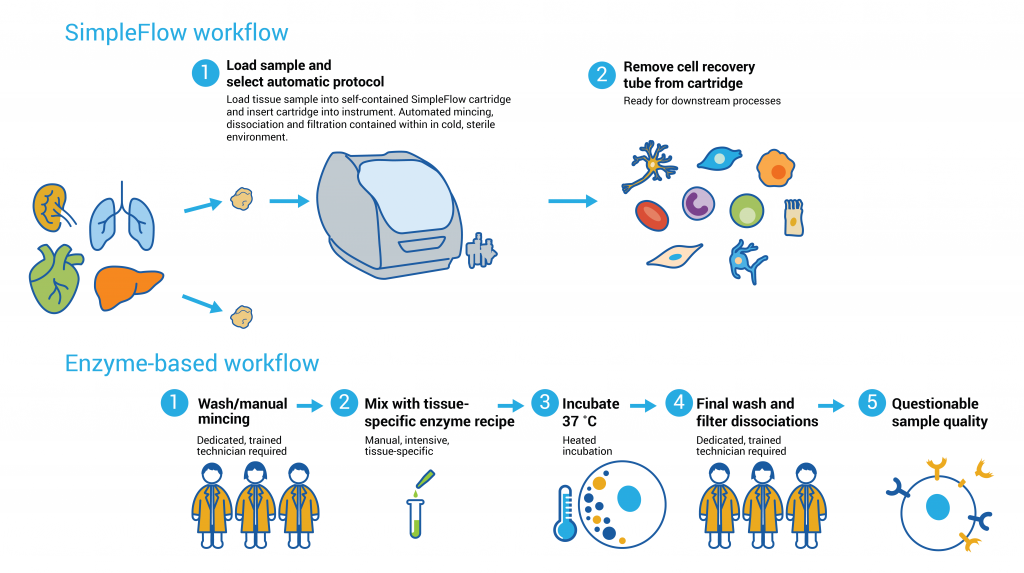
Solid tumor tissue dissociation is a delicate process. Past methods like mechanical disaggregation and chemical dissociation resulted in poor recovery for applications like single cell RNA sequencing. These tissue dissociation methods are less likely to capture all cells represented in a sample and stress the remaining cells, potentially affecting captured data. With increasing use of single cell applications across research and clinical settings, and a mounting emphasis on precision medicine, tissue dissociation techniques need to produce cells that reflect a more complete and accurate biological profile for each patient.
What tissue dissociation method is best for me
| Method | Protocol |
| Enzymatic Dissociation | Enzymatic digestion with heat, including additional washes and filtration |
| Mechanical Dissociation | Physically process tissue with cutting, crushing, scraping, or other physical forces |
| Cellsonics SimpleFlow System | BLU energy technology dissociates solid tumor tissue in an automated, cold process |
Enzymatic Dissociation
Enzymatic dissociation is a common tissue dissociation method. Minced tumor tissue is incubated on heat with a tissue-specific digestive enzyme like trypsin or collagenase. After additional washes and filtration, a single cell suspension is produced for downstream applications. These enzymes are more effective at reducing the amount of connective tissue in solid tumor samples compared to mechanical dissociation, resulting in a higher yield of desirable cells. Overall this protocol is fairly efficient after optimization to identify the ideal enzyme and incubation parameters.
Enzymatic dissociation is time intensive, both during testing parameters and performing the optimized experiment. This nuanced method makes it difficult to consistently recover viable cells. Applying heat and enzymes to tissue samples can alter the surface proteins of surviving cells. This affects data collection: FACS sorting may misidentify and discard important cell populations due to method-induced protein expression changes. This results in an incomplete representation of a heterogeneous population. Additionally, cell stress responses may be activated during enzymatic dissociation due to the harsh non-native microenvironment, artificially changing gene expression profiles. Read our blog, "Unraveling the Drawbacks of Enzymes on Tissue Dissociation" to learn more about the impact of enzymes.
Mechanical Dissociation
Mechanical dissociation is a classic, quick way to dissociate tissue. Using physical force-generating methods to grind tissue, this method works best with samples that have little connective tissue like bone marrow and lymph nodes. Post-disaggregation filtration and resuspension results in a single cell suspension that can be used in downstream applications.
However, this method results in inconsistent cell yield. There are typically fewer viable cells due to physically stressful environment. These factor into the quality of the downstream data – stressed cells are more likely to exhibit artificial gene expression changes.
Cellsonics SimpleFlow System
Here at Cellsonics, we developed a novel solid tissue dissociation method based on our BLU energy technology. Bulk Lateral Ultrasonic energy gently disaggregates solid tissue without applying heat or enzymes. This fast, automated process dissociates solid tumor tissue into a single cell suspension without stressing or losing cells to produce higher quality data in downstream applications.
Cellsonics SimpleFlow outperformed enzymatic tissue dissociation techniques on both cell population recovery and detection of native gene expression profiles. Our data demonstrate increased recovery of specific cell populations compared to enzymatic dissociation according to FACS analysis. Additionally, bulk RNA-Seq data demonstrate that tissue dissociated with the Cellsonics SimpleFlow system more closely matched the gene expression profiles of native, intact tissue than enzymatically dissociated tissue.
Our system’s demonstrated ability to consistently produce high-resolution single cell suspensions ensures accurate representation of complex tissue for clinical evaluation and research. Learn more about how Cellsonics SimpleFlow can help you with your tissue dissociations to maximize your output for downstream single cell applications.
Interested in learning more?
Ask for a 20-minute seminar from a Cellsonics Scientist


.png?width=300&height=54&name=CellsonicsLogoWhite(2048%20x%20366%20px).png)